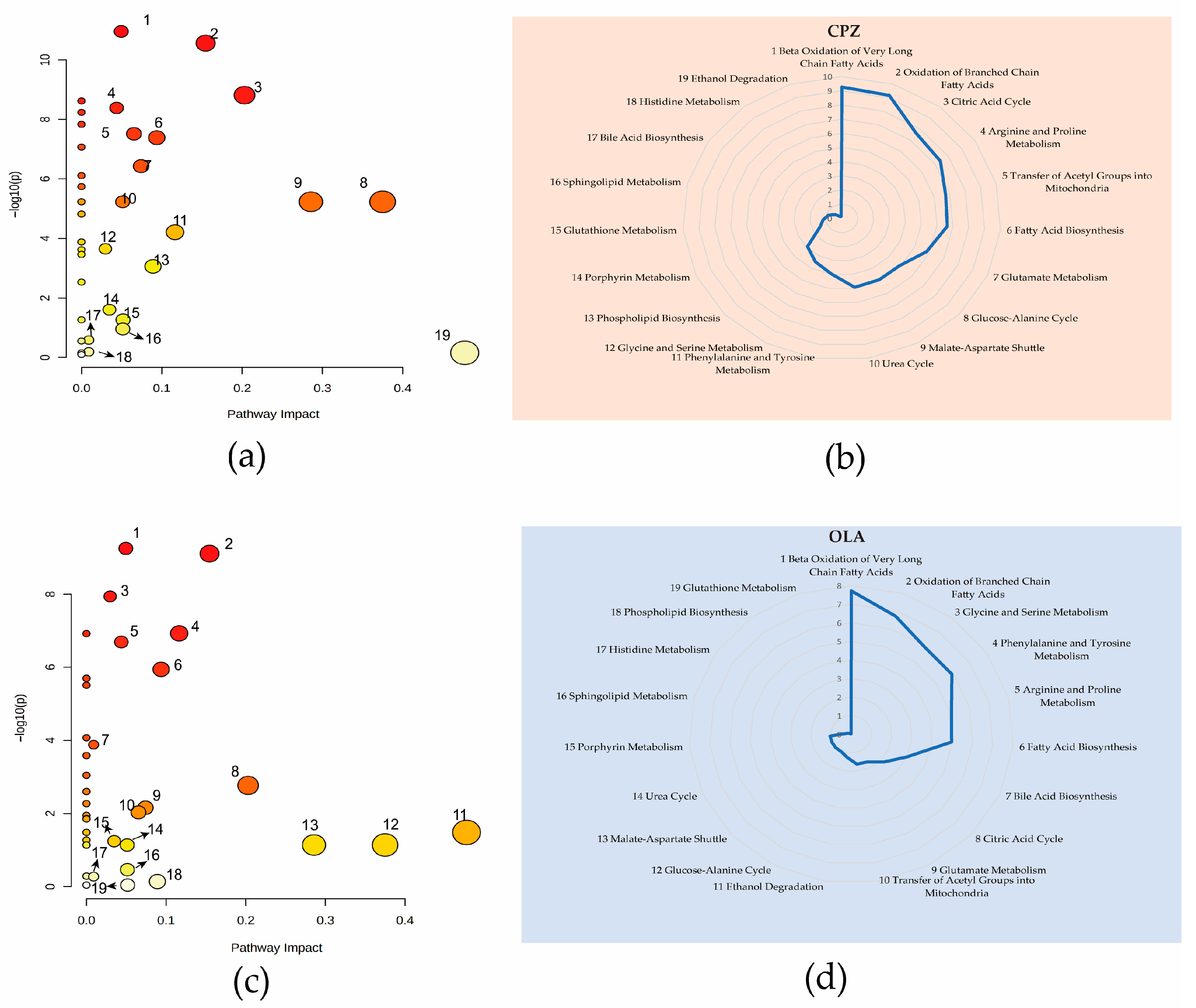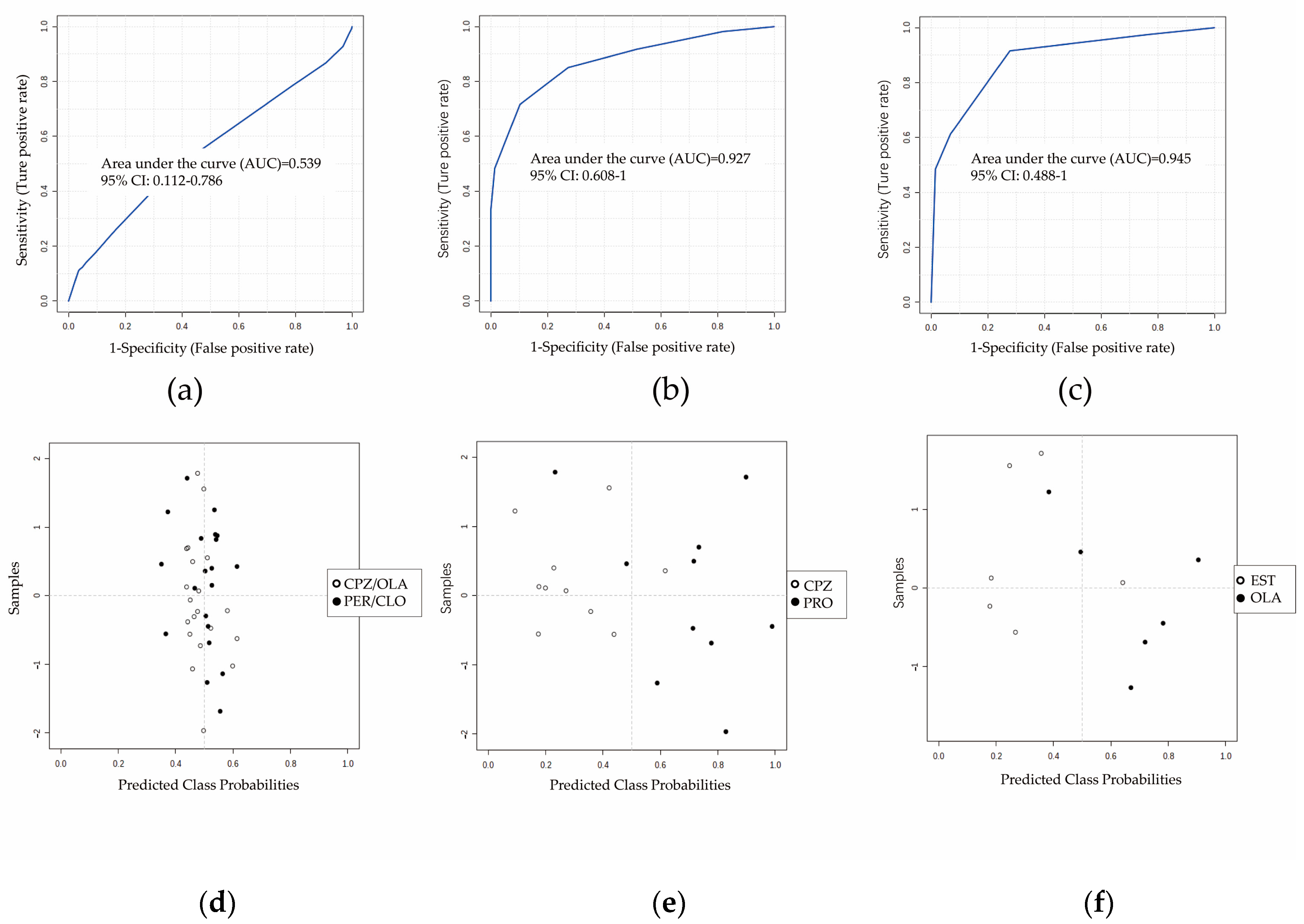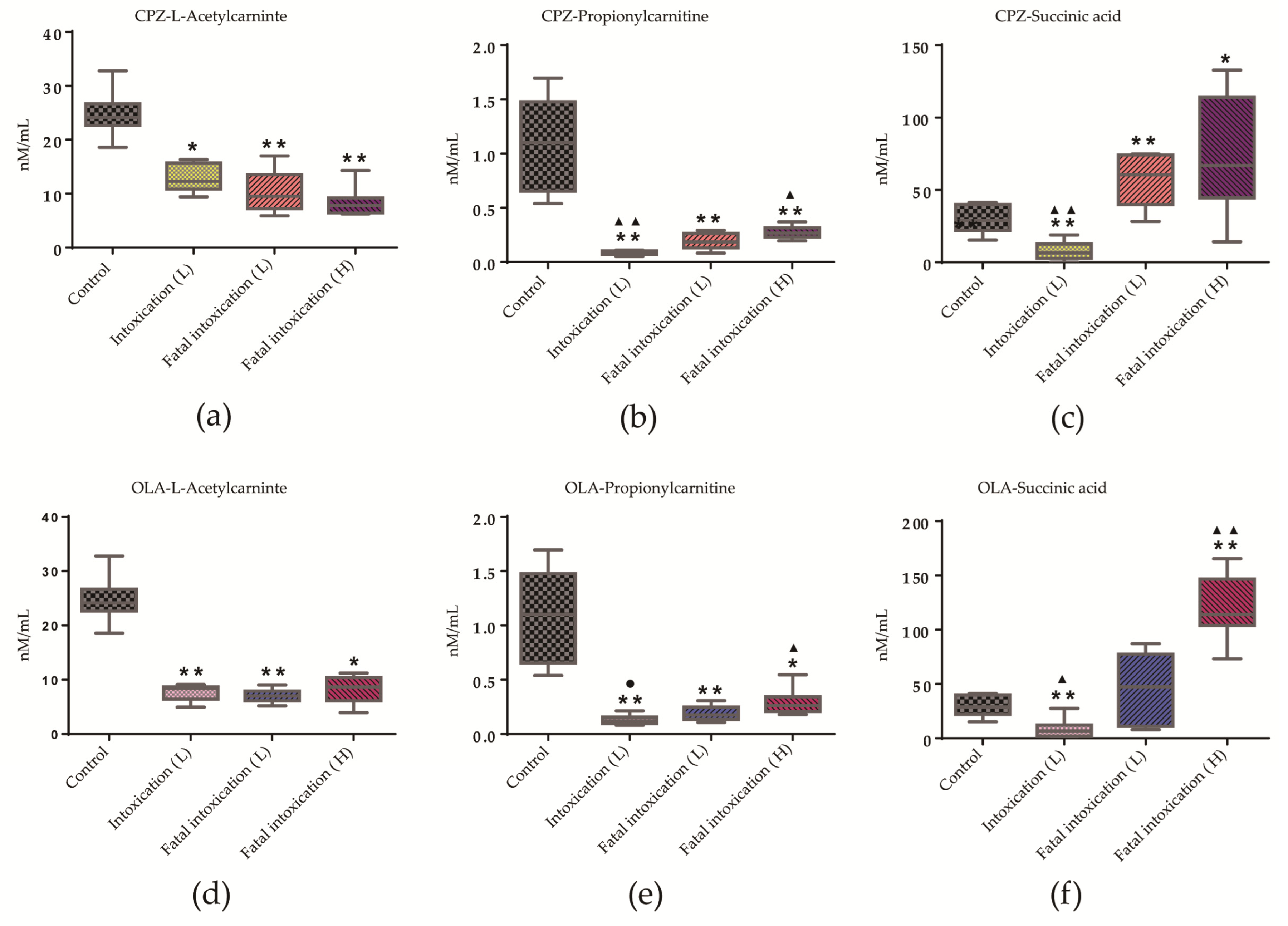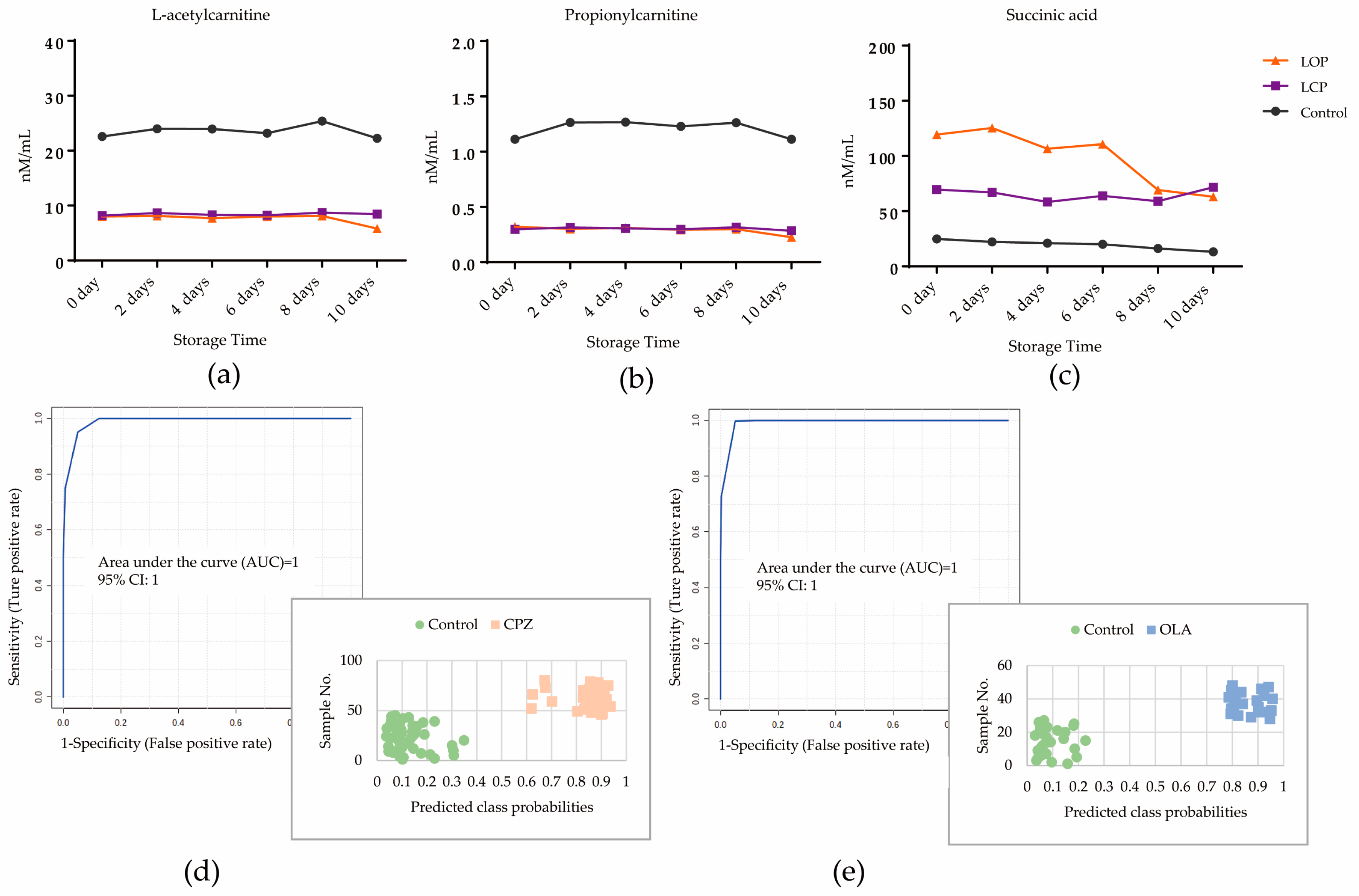Dynamic Changes in Plasma Metabolic Profiles Reveal a Potential Metabolite Panel for Interpretation of Fatal Intoxication by Chlorpromazine or Olanzapine in Mice
Abstract
:1. Introduction
2. Materials and Methods
2.1. Chemicals
2.2. Experimental Animals
2.3. Collection of Blood Samples
2.4. Extraction of Metabolites from Blood
2.5. Data Acquisition with Full Scan-MS/MS Using Liquid Chromatography-High Resolution Tandem Mass Spectrometry (LC-HR-MS/MS)
2.6. MRM Analysis by LC-MS/MS
2.7. Data Processing and Statistical Analysis for Untargeted MA
2.8. Statistical Analyses for Targeted MA
3. Results
3.1. Symptoms of Intoxication
3.2. Overall MA
3.3. Analysis of Perturbed Metabolic Pathways
3.4. Construction of a DCM
3.5. Specificity Evaluation of the Panel of Potential Metabolites
3.6. Dynamic Changes of Three Potential Metabolites at Different Drug Levels
3.7. Sensitivity Evaluation of the Potential-Metabolite Panel in Different Life States at Low Dose
3.8. Quantitative Analysis of Three Potential Metabolites in Different Life States and at Different Doses
3.9. Stability Evaluation of Three Potential Metabolites in Fresh Plasma
4. Discussion
4.1. Availability of Potential Metabolites by MA
4.2. Interpretation of L-Acetylcarnitine, Propionylcarnitine, and Succinic Acid for Fatal Intoxication
4.3. Impacts of Decomposition of Potential Metabolites on Prediction of the DCM
4.4. Limitations
5. Conclusions
Supplementary Materials
Author Contributions
Funding
Institutional Review Board Statement
Informed Consent Statement
Data Availability Statement
Conflicts of Interest
References
- Gummin, D.D.; Mowry, J.B.; Beuhler, M.C.; Spyker, D.A.; Bronstein, A.C.; Rivers, L.J.; Pham, N.P.T.; Weber, J. 2020 Annual report of the American Association of Poison Control Centers’ National Poison Data System (NPDS): 38th annual report. Clin. Toxicol. 2021, 59, 1282–1501. [Google Scholar] [CrossRef] [PubMed]
- Toft, S.; Horwitz, H.; Dalhoff, K.P. Long-term mortality after poisoning with antipsychotics. Clin. Toxicol. 2017, 55, 267–274. [Google Scholar] [CrossRef] [PubMed]
- Schreinzer, D.; Frey, R.; Stimpfl, T.; Vycudilik, W.; Berzlanovich, A.; Kasper, S. Different fatal toxicity of neuroleptics identified by autopsy. Eur. Neuropsychopharmacol. J. Eur. Coll. Neuropsychopharmacol. 2001, 11, 117–124. [Google Scholar] [CrossRef]
- Okumura, Y.; Sakata, N.; Takahashi, K.; Nishi, D.; Tachimori, H. Epidemiology of overdose episodes from the period prior to hospitalization for drug poisoning until discharge in Japan: An exploratory descriptive study using a nationwide claims database. J. Epidemiol. 2017, 27, 373–380. [Google Scholar] [CrossRef] [PubMed]
- Pan, M.; Wang, X.; Zhao, Y.; Liu, W.; Xiang, P. A retrospective analysis of data from forensic toxicology at the Academy of Forensic Science in 2017. Forensic Sci. Int. 2019, 298, 39–47. [Google Scholar] [CrossRef]
- Mowry, J.B.; Spyker, D.A.; Cantilena, L.R., Jr.; McMillan, N.; Ford, M. 2013 annual report of the American Association of Poison Control Centers’ National Poison Data System (NPDS): 31st annual report. Clin. Toxicol. 2014, 52, 1032–1283. [Google Scholar] [CrossRef] [PubMed] [Green Version]
- Solmi, M.; Murru, A.; Pacchiarotti, I.; Undurraga, J.; Veronese, N.; Fornaro, M.; Stubbs, B.; Monaco, F.; Vieta, E.; Seeman, M.V.; et al. Safety, tolerability, and risks associated with first- and second-generation antipsychotics: A state-of-the-art clinical review. Ther. Clin. Risk Manag. 2017, 13, 757–777. [Google Scholar] [CrossRef] [Green Version]
- Saar, E.; Gerostamoulos, D.; Drummer, O.H.; Beyer, J. Assessment of the stability of 30 antipsychotic drugs in stored blood specimens. Forensic Sci. Int. 2012, 215, 152–158. [Google Scholar] [CrossRef]
- DRUGBANK online. Available online: https://go.drugbank.com/drugs/DB00477 (accessed on 24 August 2022).
- Schulz, M.; Schmoldt, A.; Andresen-Streichert, H.; Iwersen-Bergmann, S. Revisited: Therapeutic and toxic blood concentrations of more than 1100 drugs and other xenobiotics. Crit. Care 2020, 24, 195. [Google Scholar] [CrossRef]
- Nedahl, M.; Johansen, S.; Linnet, K. Reference brain and blood concentrations of olanzapine in postmortem cases. J. Anal. Toxicol. 2018, 42, 650–654. [Google Scholar] [CrossRef]
- Smith, M.P.; Bluth, M.H. Forensic toxicology: An introduction. Clin. Lab. Med. 2016, 36, 753–759. [Google Scholar] [CrossRef]
- Beck, S.C.; Wilding, T.; Buka, R.J.; Baretto, R.L.; Huissoon, A.P.; Krishna, M.T. Biomarkers in human anaphylaxis: A critical appraisal of current evidence and perspectives. Front. Immunol. 2019, 10, 494. [Google Scholar] [CrossRef] [Green Version]
- Wishart, D.S. Metabolomics for investigating physiological and pathophysiological processes. Physiol. Rev. 2019, 99, 1819–1875. [Google Scholar] [CrossRef]
- Araújo, A.M.; Carvalho, F.; Guedes de Pinho, P.; Carvalho, M. Toxicometabolomics: Small molecules to answer big toxicological questions. Metabolites 2021, 11, 692. [Google Scholar] [CrossRef]
- Steuer, A.E.; Brockbals, L.; Kraemer, T. Metabolomic strategies in biomarker research—New approach for indirect identification of drug consumption and sample manipulation in clinical and forensic toxicology? Front. Chem. 2019, 7, 319. [Google Scholar] [CrossRef]
- Klingerman, C.M.; Stipanovic, M.E.; Bader, M.; Lynch, C.J. Second-generation antipsychotics cause a rapid switch to fat oxidation that is required for survival in C57BL/6J mice. Schizophr. Bull. 2014, 40, 327–340. [Google Scholar] [CrossRef] [Green Version]
- Burghardt, K.J.; Evans, S.J.; Wiese, K.M.; Ellingrod, V.L. An untargeted metabolomics analysis of antipsychotic use in bipolar disorder. Clin. Transl. Sci. 2015, 8, 432–440. [Google Scholar] [CrossRef] [PubMed] [Green Version]
- Paredes, R.M.; Quinones, M.; Marballi, K.; Gao, X.; Valdez, C.; Ahuja, S.S.; Velligan, D.; Walss-Bass, C. Metabolomic profiling of schizophrenia patients at risk for metabolic syndrome. Int. J. Neuropsychopharmacol. 2014, 17, 1139–1148. [Google Scholar] [CrossRef] [PubMed] [Green Version]
- Meister, R.; von Wolff, A.; Mohr, H.; Härter, M.; Nestoriuc, Y.; Hölzel, L.; Kriston, L. Comparative safety of pharmacologic treatments for persistent depressive disorder: A systematic review and network meta-analysis. PLoS ONE 2016, 11, e0153380. [Google Scholar] [CrossRef] [Green Version]
- Jordan, K.; Wild, T.S.N.; Fromberger, P.; Müller, I.; Müller, J.L. Are there any biomarkers for pedophilia and sexual child abuse? A review. Front. Psychiatry 2019, 10, 940. [Google Scholar] [CrossRef] [PubMed]
- Chong, J.; Wishart, D.S.; Xia, J. Using MetaboAnalyst 4.0 for comprehensive and integrative metabolomics data analysis. Curr. Protoc. Bioinform. 2019, 68, e86. [Google Scholar] [CrossRef]
- Wlodarczyk, B.J.; Ogle, K.; Lin, L.Y.; Bialer, M.; Finnell, R.H. Comparative teratogenicity analysis of valnoctamide, risperidone, and olanzapine in mice. Bipolar Disord. 2015, 17, 615–625. [Google Scholar] [CrossRef] [PubMed] [Green Version]
- Yen-Koo, H.C.; Davis, D.A.; Balazs, T. Inhibition of dopaminergic agonist-induced gnawing behavior by neuroleptic drugs in mice. Drug Chem. Toxicol. 1985, 8, 495–502. [Google Scholar] [CrossRef] [PubMed]
- Yen-Koo, H.C.; Balazs, T. Detection of dopaminergic supersensitivity induced by neuroleptic drugs in mice. Drug Chem. Toxicol. 1980, 3, 237–247. [Google Scholar] [CrossRef]
- DRUGBANK Online. Available online: https://go.drugbank.com/drugs/DB01069 (accessed on 20 August 2022).
- Coccurello, R.; Caprioli, A.; Ghirardi, O.; Conti, R.; Ciani, B.; Daniele, S.; Bartolomucci, A.; Moles, A. Chronic administration of olanzapine induces metabolic and food intake alterations: A mouse model of the atypical antipsychotic-associated adverse effects. Psychopharmacology 2006, 186, 561–571. [Google Scholar] [CrossRef]
- Krsiak, M. Effects of drugs on behaviour of aggressive mice. Br. J. Pharmacol. 1979, 65, 525–533. [Google Scholar] [CrossRef]
- Andreev-Andrievskiy, A.; Popova, A.; Lagereva, E.; Osipov, D.; Berkut, A.; Grishin, E.; Vassilevski, A. Pharmacological analysis of Poecilotheria spider venoms in mice provides clues for human treatment. Toxicon Off. J. Int. Soc. Toxinol. 2017, 138, 59–67. [Google Scholar] [CrossRef]
- Xia, G. Dietary methionine influences therapy in mouse cancer models and alters human metabolism. Nature 2019, 572, 397–401. [Google Scholar]
- Roy, C.; Tremblay, P.Y.; Bienvenu, J.F.; Ayotte, P. Quantitative analysis of amino acids and acylcarnitines combined with untargeted metabolomics using ultra-high performance liquid chromatography and quadrupole time-of-flight mass spectrometry. J. Chromatogr. B Analyt. Technol. Biomed. Life Sci. 2016, 1027, 40–49. [Google Scholar] [CrossRef]
- Chen, Y.; Zhou, Z.; Yang, W.; Bi, N.; Xu, J.; He, J.; Zhang, R.; Wang, L.; Abliz, Z. Development of a data-independent targeted metabolomics method for relative quantification using liquid chromatography coupled with tandem mass spectrometry. Anal. Chem. 2017, 89, 6954–6962. [Google Scholar] [CrossRef]
- Yin, P.; Xu, G. Current state-of-the-art of nontargeted metabolomics based on liquid chromatography-mass spectrometry with special emphasis in clinical applications. J. Chromatogr. A 2014, 1374, 1–13. [Google Scholar] [CrossRef] [PubMed]
- Zhang, K.; Zhang, A.; Liu, R.; Zhang, H.; Lin, H.; Zhang, P.; Huang, P.; Wang, Z. Identifying muscle hemorrhage in rat cadavers with advanced decomposition by FT-IR microspectroscopy combined with chemometrics. Leg. Med. 2020, 47, 101748. [Google Scholar] [CrossRef] [PubMed]
- Sun, Y.C.; Han, S.C.; Yao, M.Z.; Liu, H.B.; Wang, Y.M. Exploring the metabolic biomarkers and pathway changes in crucian under carbonate alkalinity exposure using high-throughput metabolomics analysis based on UPLC-ESI-QTOF-MS. RSC Adv. 2020, 10, 1552–1571. [Google Scholar] [CrossRef] [PubMed]
- Sumner, L.W.; Amberg, A.; Barrett, D.; Beale, M.H.; Beger, R.; Daykin, C.A.; Fan, T.W.; Fiehn, O.; Goodacre, R.; Griffin, J.L.; et al. Proposed minimum reporting standards for chemical analysis Chemical Analysis Working Group (CAWG) Metabolomics Standards Initiative (MSI). Metabolomics 2007, 3, 211–221. [Google Scholar] [CrossRef] [Green Version]
- Ning, T.; Leng, C.; Chen, L.; Ma, B.; Gong, X. Metabolomics analysis of serum in a rat heroin self-administration model undergoing reinforcement based on (1)H-nuclear magnetic resonance spectra. BMC Neurosci. 2018, 19, 4. [Google Scholar] [CrossRef]
- Norris, M.K.; Scott, A.I.; Sullivan, S.; Chang, I.J.; Lam, C.; Sun, A.; Hahn, S.; Thies, J.M.; Gunnarson, M.; McKean, K.N.; et al. Tutorial: Triheptanoin and nutrition management for treatment of long-chain fatty acid oxidation disorders. JPEN J. Parenter. Enter. Nutr. 2021, 45, 230–238. [Google Scholar] [CrossRef]
- Di Emidio, G.; Rea, F.; Placidi, M.; Rossi, G.; Cocciolone, D.; Virmani, A.; Macchiarelli, G.; Palmerini, M.G.; D’Alessandro, A.M.; Artini, P.G.; et al. Regulatory functions of L-carnitine, acetyl, and propionyl L-carnitine in a PCOS mouse model: Focus on antioxidant/antiglycative molecular pathways in the ovarian microenvironment. Antioxidants 2020, 9, 867. [Google Scholar] [CrossRef]
- Cao, B.; Jin, M.; Brietzke, E.; McIntyre, R.S.; Wang, D.; Rosenblat, J.D.; Ragguett, R.M.; Zhang, C.; Sun, X.; Rong, C.; et al. Serum metabolic profiling using small molecular water-soluble metabolites in individuals with schizophrenia: A longitudinal study using a pre-post-treatment design. Psychiatry Clin. Neurosci. 2019, 73, 100–108. [Google Scholar] [CrossRef]







| Group | Drug (Dose) | Aim |
|---|---|---|
| Fatal intoxication and Control | CPZ (H a), OLA (H) | Overall metabolomics analysis; analysis of perturbed pathways; construction of a DCM. |
| Fatal intoxication and Fatal intoxication | CPZ (H), OLA (H), clozapine (H), perphenazine (H), promethazine (H), estazolam (H) | Specificity evaluation of the panel of potential metabolites. |
| Fatal intoxication, Intoxication, Therapy, and Control | CPZ (L b and T c), OLA (L and T) | Dynamic changes of three potential metabolites at different drug levels. |
| Fatal intoxication, Intoxication, and Control | CPZ (L), OLA (L) | Sensitivity evaluation of the panel of potential metabolites. |
| Fatal intoxication, Intoxication, and Control | CPZ (H and L), OLA (H and L) | Quantitative analysis of three potential metabolites in different life states and at different doses. |
| Fatal intoxication and Control | CPZ (H), OLA (H) | Stability analysis of three potential metabolites within 10 days. |
| Compound Name a | Metabolite Identification | Pd | Trend e | VIP f | ||
|---|---|---|---|---|---|---|
| Identified Levels b | Accurate Mass c | RT c | ||||
| Chlorpromazine | 1 | 318.09555 | 10.888 | 2.82 × 10−8 | up | 1.783209 |
| L-Acetylcarnitine | 1 | 203.11574 | 9.1 | 5.77 × 10−7 | down | 1.687712 |
| Propionylcarnitine | 1 | 217.13124 | 9.878 | 5.77 × 10−7 | down | 1.45201 |
| Allantoin | 2 | 158.04388 | 0.921 | 7.66 × 10−7 | up | 1.703279 |
| Citric acid | 2 | 192.02698 | 1.526 | 0.000002 | up | 1.69585 |
| L-Carnitine | 2 | 161.10506 | 0.886 | 3.2 × 10−6 | down | 1.70532 |
| Docosahexaenoic acid | 2 | 328.24034 | 14.245 | 2.46 × 10−5 | up | 1.573368 |
| 3-Hydroxymethylglutaric acid | 2 | 162.05278 | 2.226 | 2.75 × 10−5 | up | 1.574867 |
| Oxoglutaric acid | 2 | 146.02148 | 1.526 | 4.38 × 10−5 | up | 1.561638 |
| Succinic acid | 1 | 118.02652 | 0.902 | 8.79 × 10−5 | up | 1.497697 |
| Gluconic acid | 2 | 196.05826 | 0.888 | 9.51 × 10−5 | up | 1.462974 |
| Kyotorphin | 2 | 337.1733 | 8.263 | 9.51 × 10−5 | down | 1.42069 |
| Threonic acid | 2 | 136.03716 | 0.911 | 9.51 × 10−5 | up | 1.473649 |
| Hexadecanedioic acid | 2 | 286.21451 | 12.576 | 0.000101 | up | 1.522403 |
| R-3-Hydroxydecanoic acid | 2 | 188.14122 | 11.839 | 0.000115 | down | 1.388931 |
| Dodecanedioic acid | 2 | 230.15171 | 10.764 | 0.000165 | down | 1.430021 |
| 3-Oxotetradecanoic acid | 2 | 242.18822 | 12.827 | 0.000329 | up | 1.445228 |
| Choline | 2 | 103.09959 | 0.868 | 0.000348 | up | 1.382057 |
| N-Acetyl-L-alanine | 2 | 131.05818 | 2.068 | 0.000617 | up | 1.339138 |
| Indolelactic acid | 2 | 205.07378 | 9.693 | 0.000747 | up | 1.352877 |
| L-Lysine | 2 | 146.10545 | 1.053 | 0.000747 | up | 1.399428 |
| 2-Octanamidoacetic acid | 2 | 201.13647 | 10.953 | 0.001291 | up | 1.296582 |
| Pipazethate | 2 | 399.1614 | 9.616 | 0.001915 | up | 1.217837 |
| Prostaglandin G2 2-glyceryl Ester | 2 | 442.25679 | 12.041 | 0.002218 | up | 1.263507 |
| Galactitol | 2 | 182.07882 | 0.89 | 0.004836 | up | 1.185343 |
| Indoxyl sulfate | 2 | 213.00958 | 6.979 | 0.005944 | up | 1.133043 |
| Hexanoylglycine | 2 | 173.10519 | 9.126 | 0.009866 | up | 1.086799 |
| L-Valine | 2 | 117.07885 | 0.926 | 0.023731 | down | 1.028871 |
| Compound Name | Metabolite Identification | p | Trend | VIP | ||
|---|---|---|---|---|---|---|
| Identified Levels | Accurate Mass | RT | ||||
| Olanzapine | 1 | 156.07026 | 6.742 | 1.38 × 10−9 | up | 1.874806 |
| L-Acetylcarnitine | 1 | 203.11574 | 9.1 | 9.85 × 10−8 | down | 1.763666 |
| Propionylcarnitine | 1 | 217.13124 | 9.878 | 3.44 × 10−7 | down | 1.717037 |
| Creatine | 2 | 131.06938 | 0.918 | 3.86 × 10−6 | down | 1.726218 |
| L-Carnitine | 2 | 161.10506 | 0.886 | 3.41 × 10−5 | down | 1.665984 |
| Hexadecanedioic acid | 2 | 286.21451 | 12.576 | 3.91 × 10−5 | up | 1.646536 |
| L-Methionine | 2 | 149.05097 | 0.983 | 3.91 × 10−5 | down | 1.678973 |
| L-Tyrosine | 2 | 181.07386 | 0.967 | 5.53 × 10−5 | down | 1.573716 |
| 3-Oxotetradecanoic acid | 2 | 242.18822 | 12.827 | 6.44 × 10−5 | up | 1.608964 |
| 4-Hydroxycinnamic acid | 2 | 164.0473 | 0.96 | 6.44 × 10−5 | down | 1.558905 |
| 2-Octanamidoacetic acid | 2 | 201.13647 | 10.953 | 0.000151 | up | 1.54696 |
| 12-Hydroxystearic acid | 2 | 300.26648 | 13.559 | 0.000372 | up | 1.455051 |
| Indolelactic acid | 2 | 205.07378 | 9.693 | 0.000372 | up | 1.489531 |
| Taurine | 2 | 125.01455 | 0.875 | 0.000501 | down | 1.508088 |
| Vigabatrin | 2 | 129.07892 | 0.757 | 0.001378 | down | 1.369638 |
| L-Valine | 2 | 117.07885 | 0.926 | 0.001598 | down | 1.440964 |
| Allantoin | 2 | 158.04388 | 0.921 | 0.002728 | up | 1.353355 |
| Galactitol | 2 | 182.07882 | 0.89 | 0.003248 | up | 1.230641 |
| Gluconic acid | 2 | 196.05826 | 0.888 | 0.006513 | up | 1.160182 |
| Succinic acid | 1 | 118.02652 | 0.902 | 0.006513 | up | 1.34286 |
| Leucyl-Glutamate | 2 | 260.13706 | 5.911 | 0.007345 | down | 1.281477 |
| Threonic acid | 2 | 136.03716 | 0.911 | 0.013767 | up | 1.080708 |
| R-3-Hydroxydecanoic acid | 2 | 188.14122 | 11.839 | 0.015148 | down | 1.103047 |
| LysoPC2055Z,8Z,11Z,14Z,17Z/00 | 2 | 541.31669 | 12.317 | 0.016543 | up | 1.095663 |
| Cholic acid | 2 | 408.28784 | 11.728 | 0.017701 | down | 1.137465 |
| Citric acid | 2 | 192.02698 | 1.526 | 0.018878 | up | 1.072548 |
| L-Lysine | 2 | 146.10545 | 1.053 | 0.021913 | down | 1.01019 |
| Hexanoylglycine | 2 | 173.10519 | 9.126 | 0.026868 | up | 1.004025 |
| Dodecanedioic acid | 2 | 230.15171 | 10.764 | 0.038024 | down | 1.02619 |
Publisher’s Note: MDPI stays neutral with regard to jurisdictional claims in published maps and institutional affiliations. |
© 2022 by the authors. Licensee MDPI, Basel, Switzerland. This article is an open access article distributed under the terms and conditions of the Creative Commons Attribution (CC BY) license (https://creativecommons.org/licenses/by/4.0/).
Share and Cite
Bai, R.; Dai, X.; Miao, X.; Xie, B.; Yu, F.; Cong, B.; Wen, D.; Ma, C. Dynamic Changes in Plasma Metabolic Profiles Reveal a Potential Metabolite Panel for Interpretation of Fatal Intoxication by Chlorpromazine or Olanzapine in Mice. Metabolites 2022, 12, 1184. https://doi.org/10.3390/metabo12121184
Bai R, Dai X, Miao X, Xie B, Yu F, Cong B, Wen D, Ma C. Dynamic Changes in Plasma Metabolic Profiles Reveal a Potential Metabolite Panel for Interpretation of Fatal Intoxication by Chlorpromazine or Olanzapine in Mice. Metabolites. 2022; 12(12):1184. https://doi.org/10.3390/metabo12121184
Chicago/Turabian StyleBai, Rui, Xiaohui Dai, Xingang Miao, Bing Xie, Feng Yu, Bin Cong, Di Wen, and Chunling Ma. 2022. "Dynamic Changes in Plasma Metabolic Profiles Reveal a Potential Metabolite Panel for Interpretation of Fatal Intoxication by Chlorpromazine or Olanzapine in Mice" Metabolites 12, no. 12: 1184. https://doi.org/10.3390/metabo12121184
APA StyleBai, R., Dai, X., Miao, X., Xie, B., Yu, F., Cong, B., Wen, D., & Ma, C. (2022). Dynamic Changes in Plasma Metabolic Profiles Reveal a Potential Metabolite Panel for Interpretation of Fatal Intoxication by Chlorpromazine or Olanzapine in Mice. Metabolites, 12(12), 1184. https://doi.org/10.3390/metabo12121184







